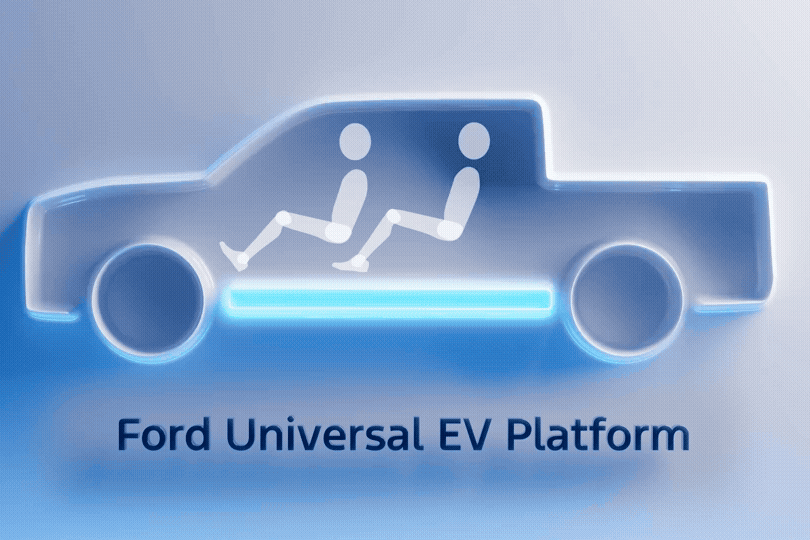Ford's bid to stay in the EV race
How a legacy automaker is fighting to be competitive in the new EV race.
I’ve referenced Fordism quite a bit in previous posts, so it’s fitting this time to focus on the company that gave the term its name. The big unveiling this week was Ford's new plan for a $30,000 electric pick that would give the company a new lifeline as the industry turns to an EV future. Such an announcement is not entirely unexpected. Without a clear response to China’s fast-moving EV makers, legacy automakers like Ford they risk being left behind.
More than a price-competitive EV, what makes Ford’s announcement stand out is its new Universal EV Platform—a major reimagining of the overarching organizational innovation that made Henry Ford a household name over a century ago: the assembly line.
The new platform will use a so-called “assembly tree,” where the front, middle (housing the structural battery pack), and rear of the vehicle are built independently and in parallel, then brought together for final assembly. Ford also says the platform will cut parts count by roughly 20%, eliminate about 4,000 feet of wiring to make vehicles significantly lighter, and boost production speed by an estimated 15%. All of this is aimed at helping the company that once pioneered mass car production now build EVs at a price low enough to compete in today’s EV race.
Understanding which kinds of firms are capable of innovation and where within the market they belong has long been a focus of mine—and a recurring theme of this newsletter. We often think of breakthrough innovations as emerging from outside the circle of incumbents, driven by entrepreneurs on the periphery. This is a dynamic Joseph Schumpeter famously described as creative destruction. Ford’s latest move, however, is a striking example of an incumbent making an aggressive play to stay relevant.
Market leaders rarely have strong incentives to radically overhaul their products or processes when they already dominate—and this certainly applies to Ford, whose F-Series trucks have been among the best selling vehicles in the U.S. for decades. Newcomers, by contrast, have everything to gain by challenging the status quo, making them much more likely to adopt new and riskier technologies. Tesla’s popularization of the EV is the most recent and striking example in the sector. The company likes to characterize itself not as an carmaker, but as a Silicon Valley tech company that just happened to make cars—a clear outsider to the inner and much more established core of American car makers.
This is why Ford's newest move is worth paying attention to. Ford might never have undertaken such an aggressive overhaul of its product line and production methods without Tesla’s (and now China’s EV makers’) disruption to the market. But that doesn’t change the fact that such drastic changes within a company that continues to produce one of the nation’s best-selling vehicles is worth paying attention.
How can incumbents innovate?
New innovation can be extremely challenging for incumbents in any sector. Instigating processes that propel new innovation within a large established organization can be a bit like steering giant ship already moving at full speed. Their internal processes, hierarchies, and norms carry with them a kind of inertia, often designed—consciously or not—to reinforce the status quo.
The big Detroit automakers of the 20th century, Ford among them, excelled at mass-producing cars in an execution-focused environment built to crank out reliable products at scale. But that very strength meant also that these firms didn't encourage or reward unconventional or creative thinking—let alone the adoption of risky new technologies. And in the case of EVs, this makes sense as it can mean cannibalizing their existing and highly profitable product lineup.
How, then, can legacy automakers pivot to new technologies like EVs when so much inertia is working against them? How this happens is a key theme in my newsletter. In Ford’s case, the company took two important steps. First, it created a skunkworks project—the initiative that ultimately produced the new Universal EV Platform. The term "skunkworks" originated at Lockheed Martin during World War II, when a small, team was tasked with rapidly developing advanced aircraft free from the bureaucracy of the larger organization. The key idea is to carve out a part of the organization that can operate autonomously and take on much more experimental projects.
And that's exactly what Ford did with its new EV unit: set up an isolated, autonomous unit that operates outside the company’s usual structures, thereby giving it the freedom to bypass entrenched processes, break with conventional thinking, and take on much riskier approaches. As Ford CEO Jim Farley put it last year, the skunkworks team was "separate from the Ford mothership" and operated like "a start-up" within the broader company.
Bringing Silicon Valley and EV talent to Ford
Step two is not only to adopt the start-up ethos of Silicon Valley, but to quite literally bring in Silicon Valley veterans who've worked on EVs to lead the new effort. The first key hire by Ford was Alan Clarke, who spent 12 years at Tesla and played a key role in engineering Tesla's cars. He was then joined by Doug Field, another tech industry veteran who worked at Segway (the company's second hire), Apple (where he oversaw the best-selling MacBook Air) and Tesla (leading production of the Model 3 sedan).
Now serving as Ford’s Chief of EVs, Field has also become a talent magnet (here’s a nice profile of Field). Under his leadership, the legacy carmaker has brought in dozens of engineers from top EV players to their new EV initiative—last year alone hiring 50 from Rivian, over 20 from Tesla, about a dozen from Canoo, 10 from Lucid, and several from Apple’s now-canceled Project Titan.[1]
These hires play a key role in transferring the tacit knowledge of EV production into Ford. They carry with them the lessons, best practices, and problem-solving instincts honed over years of designing and building EVs at scale. And now, by pairing this with the company’s manufacturing muscle, Ford is attempting to marry the innovation of the EV upstarts with the production capabilities of one of the world’s most experienced automakers.
Of course, it’s far too early to know whether this will propel Ford into the ranks of leading EV makers. The first $30,000 models aren’t slated to hit the market until 2027—a lifetime in a fast-moving industry where much can change before then. Still, the early production gains (e.g., the 15% boost in production speed) Ford reported last week are promising—and worth watching closely.
Global EV race
By now, China's BYD has prevailed as the largest and most relevant EV maker. And with it, its model has become the one to beat. But its clear from this week's announcement that Ford’s EV team isn’t trying to out-BYD BYD.
The Chinese automaker’s competitive edge comes from its massive scale (employing some 700,000 employees) and deep vertical integration—especially in battery manufacturing, where it controls everything from raw material processing to final assembly and now even recycling. That scale gives BYD an almost unassailable cost advantage. And Ford knows it can’t win at that game (especially while manufacturing in the U.S. where labor costs are so much higher).
Instead, Ford's Universal EV Platform team has focused on engineering innovation. In one example that Field described, they built a propulsion system "like Apollo 13," engineered down to the watt so that the vehicle’s battery could be dramatically smaller than BYD’s while still delivering competitive performance. If you can’t match a BYD’s cost structure on the battery, make the rest of the system so efficient that you don’t need as much battery in the first place. As Ford CEO Jim Farley said in a Wired interview, “We can’t beat them on scale. We can’t beat them on vertical integration. But we can beat them on innovation.”
This difference strikes me as one of incremental vs radical innovation. BYD’s approach is more incremental, building on its existing strengths—scale, vertical integration, and battery manufacturing prowess—making steady, cumulative improvements at every stage of their production line to lower costs and optimize performance.
Ford’s strategy, by contrast, feels much closer to radical innovation: rather than refining existing production processes and retooling their factories for the EV age, it’s rethinking core elements of car design and manufacturing from the ground up. This kind of leap, while riskier, has the potential to shift the competitive landscape in ways that incremental improvements alone rarely do.
Whether legacy carmakers can use this riskier approach to catch up in the EV race remains to be seen—and by the time Ford’s results are clear, BYD may have pulled even further ahead. Worse still, Trump’s “Big Beautiful Bill” is putting an end to EV tax credits at the end of September, making the timing of Ford’s Universal EV Platform unfortunately quite unlucky. Still, with Ford’s new EV initiative, it’s far too early to count the America's top legacy carmaker out of the game.



